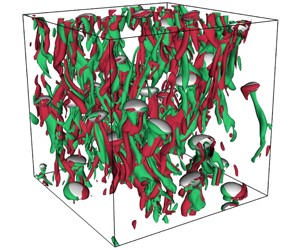Crossref Citations
This article has been cited by the following publications. This list is generated based on data provided by
Crossref.
Chu, Xu
Liu, Yanchao
Wang, Wenkang
Yang, Guang
Weigand, Bernhard
and
Nemati, Hassan
2020.
Turbulence, pseudo-turbulence, and local flow topology in dispersed bubbly flow.
Physics of Fluids,
Vol. 32,
Issue. 8,
Ramadugu, Rashmi
Pandey, Vikash
and
Perlekar, Prasad
2020.
Pseudo-turbulence in two-dimensional buoyancy-driven bubbly flows: A DNS study.
The European Physical Journal E,
Vol. 43,
Issue. 11,
Zhang, Lingxin
Peng, Kai
Shao, Xueming
and
Deng, Jian
2021.
Direct numerical simulation of deformable rising bubbles at low Reynolds numbers.
Physics of Fluids,
Vol. 33,
Issue. 11,
Trautner, E.
Klein, M.
Bräuer, F.
and
Hasslberger, J.
2021.
Conditional and unconditional second-order structure functions in bubbly channel flows of power-law fluids.
Physics of Fluids,
Vol. 33,
Issue. 5,
Ma, Tian
Ott, Bernhard
Fröhlich, Jochen
and
Bragg, Andrew D.
2021.
Scale-dependent anisotropy, energy transfer and intermittency in bubble-laden turbulent flows.
Journal of Fluid Mechanics,
Vol. 927,
Issue. ,
Le Roy De Bonneville, F.
Zamansky, R.
Risso, F.
Boulin, A.
and
Haquet, J.-F.
2021.
Numerical simulations of the agitation generated by coarse-grained bubbles moving at large Reynolds number.
Journal of Fluid Mechanics,
Vol. 926,
Issue. ,
Fox, Rodney O.
2021.
Advanced Approaches in Turbulence.
p.
307.
Innocenti, Alessio
Jaccod, Alice
Popinet, Stéphane
and
Chibbaro, Sergio
2021.
Direct numerical simulation of bubble-induced turbulence.
Journal of Fluid Mechanics,
Vol. 918,
Issue. ,
du Cluzeau, A.
Bois, G.
Leoni, N.
and
Toutant, A.
2022.
Analysis and modeling of bubble-induced agitation from direct numerical simulation of homogeneous bubbly flows.
Physical Review Fluids,
Vol. 7,
Issue. 4,
Paul, I.
Fraga, B.
Dodd, M. S.
and
Lai, C. C. K.
2022.
The role of breakup and coalescence in fine-scale bubble-induced turbulence. I. Dynamics.
Physics of Fluids,
Vol. 34,
Issue. 8,
Brandt, Luca
and
Coletti, Filippo
2022.
Particle-Laden Turbulence: Progress and Perspectives.
Annual Review of Fluid Mechanics,
Vol. 54,
Issue. 1,
p.
159.
Zhang, Lingxin
Peng, Kai
Shao, Xueming
and
Deng, Jian
2022.
Short-range repulsive force model for near-contact interactions of bubbles.
Physical Review E,
Vol. 106,
Issue. 4,
Zhang, Ling-xin
Cheng, Xin-sheng
Zhou, Ze-cai
Gao, Qi
and
Shao, Xue-ming
2022.
An experimental study on the velocity fluctuations generated by the flow past fixed spheres.
Journal of Hydrodynamics,
Vol. 34,
Issue. 2,
p.
214.
Ma, Tian
Hessenkemper, Hendrik
Lucas, Dirk
and
Bragg, Andrew D.
2022.
An experimental study on the multiscale properties of turbulence in bubble-laden flows.
Journal of Fluid Mechanics,
Vol. 936,
Issue. ,
Pandey, Vikash
Mitra, Dhrubaditya
and
Perlekar, Prasad
2022.
Turbulence modulation in buoyancy-driven bubbly flows.
Journal of Fluid Mechanics,
Vol. 932,
Issue. ,
Wang, Cheng
Jiang, Linfeng
and
Sun, Chao
2023.
Numerical study on turbulence modulation of finite-size particles in plane-Couette flow.
Journal of Fluid Mechanics,
Vol. 970,
Issue. ,
Ma, Tian
Hessenkemper, Hendrik
Lucas, Dirk
and
Bragg, Andrew D.
2023.
Effects of surfactants on bubble-induced turbulence.
Journal of Fluid Mechanics,
Vol. 970,
Issue. ,
Ramadugu, Rashmi
Pandey, Vikash
and
Perlekar, Prasad
2023.
Energy spectra of buoyancy-driven bubbly flow in a vertical Hele-Shaw cell.
Frontiers in Physics,
Vol. 11,
Issue. ,
Pandey, Vikash
Mitra, Dhrubaditya
and
Perlekar, Prasad
2023.
Kolmogorov Turbulence Coexists with Pseudo-Turbulence in Buoyancy-Driven Bubbly Flows.
Physical Review Letters,
Vol. 131,
Issue. 11,
Liu, Yanchao
Wang, Wenkang
Yang, Guang
Nemati, Hassan
and
Chu, Xu
2023.
The interfacial modes and modal causality in a dispersed bubbly turbulent flow.
Physics of Fluids,
Vol. 35,
Issue. 8,

 $150\leqslant Re\leqslant 546$) and Atwood (
$150\leqslant Re\leqslant 546$) and Atwood ( $0.04\leqslant At\leqslant 0.9$) numbers. We study the probability distribution function of the horizontal and vertical liquid velocity fluctuations and find them to be in quantitative agreement with the experiments. The energy spectrum shows a
$0.04\leqslant At\leqslant 0.9$) numbers. We study the probability distribution function of the horizontal and vertical liquid velocity fluctuations and find them to be in quantitative agreement with the experiments. The energy spectrum shows a  $k^{-3}$ scaling at high
$k^{-3}$ scaling at high  $Re$ and becomes steeper on reducing
$Re$ and becomes steeper on reducing  $Re$. To investigate spectral transfers in the flow, we derive the scale-by-scale energy budget equation. Our analysis shows that, for scales smaller than the bubble diameter, the net transfer because of the surface tension and the kinetic energy flux balances viscous dissipation to give
$Re$. To investigate spectral transfers in the flow, we derive the scale-by-scale energy budget equation. Our analysis shows that, for scales smaller than the bubble diameter, the net transfer because of the surface tension and the kinetic energy flux balances viscous dissipation to give  $k^{-3}$ scaling of the energy spectrum for both low and high
$k^{-3}$ scaling of the energy spectrum for both low and high  $At$.
$At$.